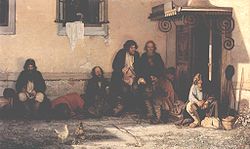
Zemstvo
Encyclopedia

Local government
Local government refers collectively to administrative authorities over areas that are smaller than a state.The term is used to contrast with offices at nation-state level, which are referred to as the central government, national government, or federal government...
that was instituted during the great liberal reforms performed in Imperial Russia by Alexander II of Russia
Alexander II of Russia
Alexander II , also known as Alexander the Liberator was the Emperor of the Russian Empire from 3 March 1855 until his assassination in 1881...
. The idea of the zemstvo was elaborated by Nikolay Milyutin
Nikolay Milyutin
Nikolay Alexeyevich Milyutin was a Russian statesman remembered as the chief architect of the great liberal reforms undertaken during Alexander II's reign, including the emancipation of the serfs and the establishment of zemstvo.-Early life:Nikolay Milyutin was born in Moscow, Russia on June 6,...
, and the first zemstvo laws were put into effect in 1864. After the October Revolution
October Revolution
The October Revolution , also known as the Great October Socialist Revolution , Red October, the October Uprising or the Bolshevik Revolution, was a political revolution and a part of the Russian Revolution of 1917...
of 1917, the zemstvo system was shut down in most of Russia, only remaining where the Bolshevik
Bolshevik
The Bolsheviks, originally also Bolshevists , derived from bol'shinstvo, "majority") were a faction of the Marxist Russian Social Democratic Labour Party which split apart from the Menshevik faction at the Second Party Congress in 1903....
s failed to take power.
The system of local self-government in the Russian Empire was presented at the lowest level by mir and volost
Volost
Volost was a traditional administrative subdivision in Eastern Europe.In earlier East Slavic history, volost was a name for the territory ruled by the knyaz, a principality; either as an absolute ruler or with varying degree of autonomy from the Velikiy Knyaz...
s and was continued, so far as the 34 Guberniya
Guberniya
A guberniya was a major administrative subdivision of the Russian Empire usually translated as government, governorate, or province. Such administrative division was preserved for sometime upon the collapse of the empire in 1917. A guberniya was ruled by a governor , a word borrowed from Latin ,...
s of old Russia are concerned, in the elective district and provincial assemblies (zemstvos).
These bodies, one for each district and another for each province or government, were created by Alexander II in 1864. They consisted of a representative council (zemskoye sobranye) and of an executive board (zemskaya uprava) nominated by the former. The board consists of five classes of members:
- large landed proprietors (nobles owning 590 acres (2.4 km²) and over), who sit in person;
- delegates of the small landowners, including the clergy in their capacity of landed proprietors;
- delegates of the wealthier townsmen;
- delegates of the less wealthy urban classes;
- delegates of the peasants, elected by the volosts.
The nobles were given more weight in voting for a zemstvo, as evidenced by the fact that 74% of the zemstvo members were nobles, even though nobles were 1.3% of the population. Even so, the zemstvo did allow the greater population more say in the ways they wanted a small part of their lives to be run.
The rules governing elections to the zemstvos were taken as a model for the electoral law of 1906 and are sufficiently indicated by the account of this given below. The zemstvos were originally given large powers in relation to the incidence of taxation, and such questions as education, medical relief, public welfare, food supply, and road maintenance in their localities, but were met with hostility by radical
Radicalism (historical)
The term Radical was used during the late 18th century for proponents of the Radical Movement. It later became a general pejorative term for those favoring or seeking political reforms which include dramatic changes to the social order...
s, such as the Socialist Revolutionary Party and the nihilists
Nihilist movement
The Nihilist movement was a Russian movement in the 1860s which rejected all authorities. It is derived from the Latin word "nihil", which means "nothing"...
who wanted more reform. These powers were, however, severely restricted by the emperor Alexander III
Alexander III of Russia
Alexander Alexandrovich Romanov , historically remembered as Alexander III or Alexander the Peacemaker reigned as Emperor of Russia from until his death on .-Disposition:...
(law of 12/25 June 1890), the zemstvos being subordinated to the governors, whose consent was necessary to the validity of all their decisions, and who received drastic powers of discipline over the members.
During the fifty years of their existence, zemstvo institutions succeeded in solving in the proper way many problems of general education, public medical service, ways of transportation and agronomy.
Zemstvo expenditure grew from 89,100,000 Rubles in 1900 to 290,500,000 Rubles in 1913. Of the latter sum 90,100,000 Rubles were spent on education, 71,400,000 on medical assistance, 22,200,000 on improvements in agriculture and 8,000,000 on veterinary measures. The chief source of zemstvo revenue were rates on lands, forests, country dwellings, factories, mines and other real estate.
The term Zemstvo stamp
Zemstvo stamp
A Zemstvo stamp was a Russian local stamp used widely in rural areas from 1865. It was named after the Zemstvo local administrative districts created in 1864. The stamps ceased at about the time of the 1917 Russian revolution.- Background :...
is also used in philately
Philately
Philately is the study of stamps and postal history and other related items. Philately involves more than just stamp collecting, which does not necessarily involve the study of stamps. It is possible to be a philatelist without owning any stamps...
to refer to local-issue Russian postage stamps from this period.

